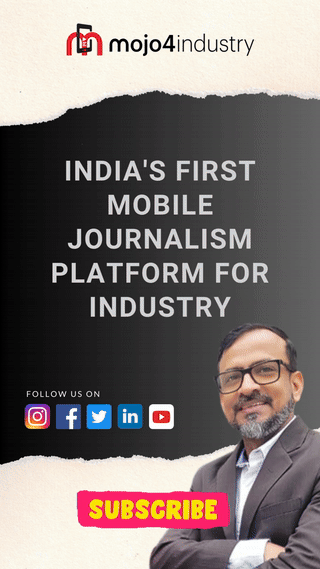APAR Industries | Exclusive from DistribuELEC 2024
APAR Industries, a diversified billion-dollar company with a global presence is a trusted manufacturer and supplier of conductors, a wide range of cables, specialty oils, polymers, and lubricants.
On the sidelines of DistribuELEC 2024, mojo4industry spoke to Kushal Desai, Chairman & Managing Director, of APAR Industries; Chaitanya Desai, Managing Director, of APAR Industries; and Shashi Amin, CEO – Cable Solutions, APAR Industries; where Mr. Kushal spoke about the key growth drivers for APAR Industries, Mr. Chaitanya spoke about India’s anti-dumping duties products to guard local manufacturers against cheap imports from neighboring countries and his views on a similar policy for the electrical equipment industry; and Mr. Shashi spoke about the key innovations visitors experienced at the DistribuELEC 2024.
In the past decade, significant technological developments have occurred in the industry. What are your thoughts on the ongoing energy transition?
Kushal Desai: Currently, electricity constitutes around 20% of the overall energy mix. Looking ahead 25–30 years into the 2050s, the projection is that energy consumption will double, with electricity’s share expected to increase from 20% to 40%. This doubling of electricity intensity raises concerns about carbon emissions, which are already exceeding acceptable levels. The critical question is how to address emissions when electricity consumption doubles.
The solution lies in the growing emphasis on renewable energy sources. The majority of new energy additions will come from renewables, specifically zero-emission sources. Solar and wind energy, among other renewable forms, are key players in this transition, replacing current energy sources and ultimately reducing emissions to required levels.
What are some key growth drivers for APAR Industries?
Kushal Desai: The primary areas of growth in our business include renewable energy expansion, encompassing generation and distribution. Another significant growth sector is mobility, focusing on the transition to electric forms to reduce emissions. This shift is evident in the electrification of buses and the emphasis on expanding railway infrastructure, with India moving from diesel to electric networks.
Our product portfolio caters to these developments, offering items like copper conductors and alloy conductors for railway electrification, cables for various vehicles, including two-wheelers, four-wheelers, electric buses, and charging circuits. Additionally, a substantial growth area in our conductor business involves the reconduction of old transmission lines. This process enables existing lines to carry more power, especially in locations where additional right-of-way is not available. Our developed solutions allow for a significant increase, up to 300%, in power transmission on the same live line infrastructure, replacing it in sections.
Conductors Business contributes the highest revenue as far as your business verticals are concerned. Going forward, can we see some shift in this as renewable, emobility is at the center stage?
Chaitanya Desai: Renewable energy significantly drives our business, creating demand for conductors, cables, and transformers. Our products play a crucial role in the transformer industry, contributing to the growth witnessed in India and globally, a trend expected to persist for the next decade.
In the conductor business, customer requirements are evolving to align with the demand for renewable energy. The emphasis is on robust systems that can handle increased power throughput. The government’s focus on reducing line losses is noteworthy, with India already achieving a commendable reduction from 27% to 15%. The next target is 12%, and our conductors are designed to contribute to this goal by minimizing power loss.
India has imposed anti-dumping duties on a few products to guard local manufacturers against cheap imports from the neighboring country. Mr. Chaitanya, what’s your assessment of this policy? Do you expect anything similar from the electrical equipment industry?
Chaitanya Desai: The Indian government consistently supports the domestic industry by addressing unlawful practices like dumping, and strictly adhering to WTO guidelines. They impose anti-dumping duties where necessary to eliminate unfair trade practices. Currently, APAR’s products face minimal dumping challenges in the Indian industry. However, if such issues arise in the future, I am confident that the Indian government will continue to support the domestic industry.
Could you tell us about the essence of your exhibit and give us an overview of some key innovations visitors will experience?
Shashi Amin: APAR is a company focused on innovation. Throughout our history, we have developed most of our products and collaborated closely with the defense sector to adapt imported cables to our specifications and design. Aligning with the ‘Atmanirbhar Bharat’ initiative, we have a strong partnership with defense. In the Vande Bharat train, over 90% of the cables used are from APAR, and we continue to work closely on various projects, with 32-33 trains currently in operation.
We have also introduced a fire survival cable capable of withstanding temperatures up to 1050°C. Notably, we are the sole company producing an electron beam house wire, highlighting the superiority of our product compared to conventional wires. Our participation in this exhibition aims to showcase these innovative products.
Can you enlighten our viewers about your short- and long-term objectives to achieve?
Kushal Desai: This presents a substantial opportunity not only within India but also globally, with countries worldwide participating in COP 27 and COP 28. Companies operating in the electrical infrastructure sector, including us, stand to benefit significantly from this global initiative. Anticipating robust growth, with potential annual increases exceeding 10-15%, for a considerable period as infrastructure projects unfold.
As part of our management strategy, we are focused on ensuring we have the appropriate products and approvals in place. This includes obtaining licenses required for supplying in various geographical locations to capitalize on this widespread opportunity.
Watch the interview now!






